
Pujin Ferry, located in now Yongji City, Shanxi Province, was a famous ferry crossing in the ancient Yellow River. In the thirteenth year of the reign of Kaiyuan period in the Tang Dynasty (the year of 725), local residents cast iron bulls on both sides of the Yellow River on an imperial order. Boats were tied with iron chains to build the first fixed iron chain bridge on the Yellow River. Later, due to the diversion of the Yellow River, the iron bulls were submerged in the water and buried in the sand. In the late 1980s, the cultural relics of iron bulls in the Yellow River were discovered by archaeological excavations.
In 1995, the Shanxi Provincial Postal Telegraph and Telephone Administration distributed a series of regular envelops under the theme of landscape in Shanxi. One of them was about the iron bulls in the Yellow River. This themed envelope is collected in Steel Structure Museum. It is printed with a sketch image of the iron bulls on the front, pasted with postage and stamped with a commemorative postmark, which gives it certain collection value.
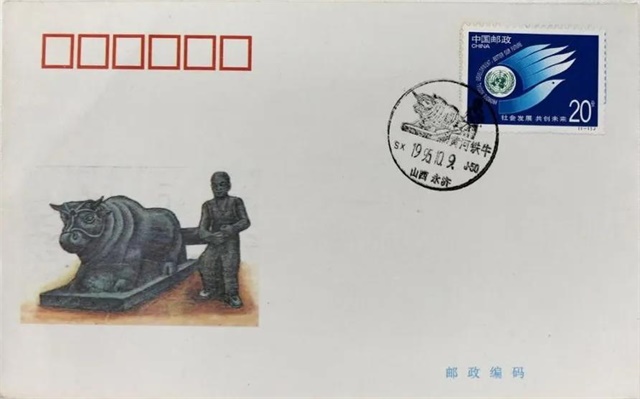
The collected themed envelope
History of Pujin Bridge
Located in the west of Puzhou Town, Yongji City, Shanxi Province, the ancient city of Puzhou is the first key from Hedong and Hebei to Central Shanxi via land transport and has always been a battlefield of critical importance. Due to its important geographical location and stable river bed conditions, the Pujin Ferry in the urban fringe became the preferred site for the construction of river bridges over different dynasties.
Pujin Ferry has a long history. The floating bridge in Pujin was built in 541 BC and was destroyed in 1911. For more than 2,400 years, it experienced ups and downs and vicissitudes in five stages.
The first stage marked a temporary floating bridge. According to The Commentary of Zuo, in the first year of the reign of Lu Zhao (541 BC), "Qin Bo's younger brother, Zhen, escaped to the Kingdom of Jin", "Zhen became a high official in the Kingdom of Jin and built boats on the river". The Primary Anthology written by Xu Jian in the Tang Dynasty further described, "Zhen built boats in Xiayangjin, Puban, where now the floating bridge in Pujin is located."
The second stage marked the first permanent floating bridge on the Yellow River. During the Warring States period, Emperor Zhaoxiang of the Qin Dynasty expanded eastward and built floating bridges in Pujin twice. According to The Continued Spring and Autumn Annals, "The first floating bridge was built over river in the Qin Dynasty" in the 20th year of the reign of Emperor Zhaoxiang (295 BC). According to The Historical Records. The History of Qin Dynasty, in the 50th year of Emperor Zhaoxiang, "The first floating bridge was built" in Pujin Ferry. Later, When Emperor Liu Bang in the Han Dynasty conquered the Central Shaanxi Plain and when Cao Cao, King Wu of Wei Kingdom, went on a punitive expedition to the Xiliang Dynasty, both of them kept repairing the floating bridge.
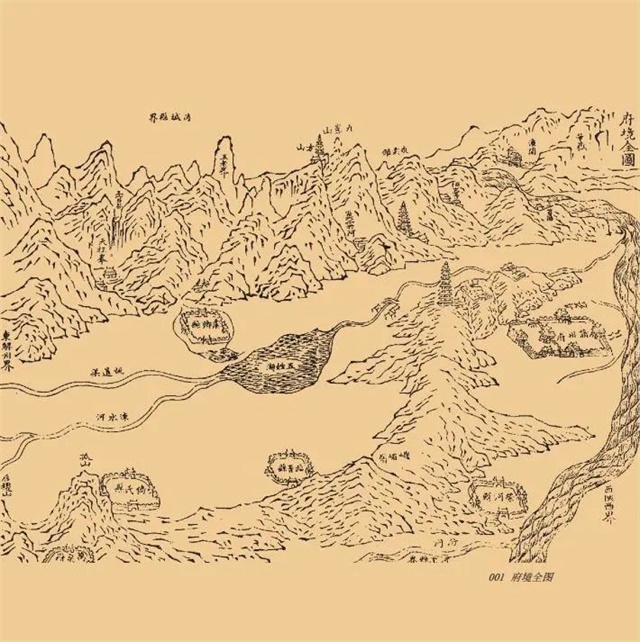
A Panoramic View of Hezhongfu
In the third stage, over about 337 years from the first year of the reign of Emperor Dengguo in the Northern Wei Dynasty (the year of 386) to the eleventh year of the reign of Emperor Kaiyuan in the Tang Dynasty (the year of 723), Pujin Bridge remained a fixed curved floating bridge formed by ships connected by bamboo cables. According to historical records, this floating bridge was traveled by King Gao Huan of Qi when he went to attack the Western Wei Dynasty, Yu Wentai, the Prime Minister of the Western Wei Dynasty, conquered Qinzhou, and Yang Jian, Emperor Wen of Sui Dynasty, visited Hedong. After Li Yuan, Emperor Taizu of Tang, raised an army in Jinyang in the late Sui Dynasty, Jue Tutong, a general of Sui, broke the river bridge in order to stop soldiers of the Tang Dynasty.
The fourth stage was from the twelfth year of the reign of Emperor Kaiyuan in the Tang Dynasty (the year of 724) to the first year of the reign of Emperor Yuanguang in the Jin Dynasty (1222). Pujin Bridge was a fixed arc floating bridge formed by ships connected by iron chains. In the eighth year of the reign of Emperor Kaiyuan, Puzhou was ranked among the "six great cities" with Shaan, Zheng, Bian, Jiang, and Huai. In the twelfth year of the reign of Emperor Kaiyuan (the year of 724), in order to strengthen the rule of the Central Plains and the north, Emperor Xuanzong of Tang ordered a complete renovation of Pujin Bridge that would change the "bamboo cables" to "iron chains" and include cast anchored iron bulls, iron men, iron pillars, etc. According to Tong Dian of Du you in the Tang Dynasty, “There is a Pujin Pass in the east of the river. In the twelfth year of the reign of Emperor Kaiyuan, the east and west gates were opened on both sides of the Yellow River. Four iron bulls were made for each, and sixteen iron pillars were placed before and after the gates. The bulls were connected with iron pillars in the belly, and the iron pillars were buried underground at a depth of more than one zhang (1 zhang = 3 1/3m)." This project was definitely a major national project at that time, because the annual output of cast iron in the country was only more than 2 million jin (1 jin =1/2 kilogram) and Pujin Bridge consumed about 1.6 million jin, or four fifths of the national output. In the eighth year of the reign Emperor Jiayou in the Northern Song Dynasty (1063), the river soared and the iron bulls were submerged. Huai Bing, a monk from Zhengding, fished out the iron bulls based on the principle of buoyancy and repaired the floating bridge; in order to make the country prosper and the army strong, Zhao Xu, Emperor Shenzong of the Song Dynasty, also ordered many repairs of Pujin Bridge. In November of the first year of the reign of Emperor Yuanguang in the Jin Dynasty (1222), armies of the Jin and Yuan Dynasties competed for Puzhou City, and Hou Xiaoshu, a general of Jin, "burned the floating bridge."
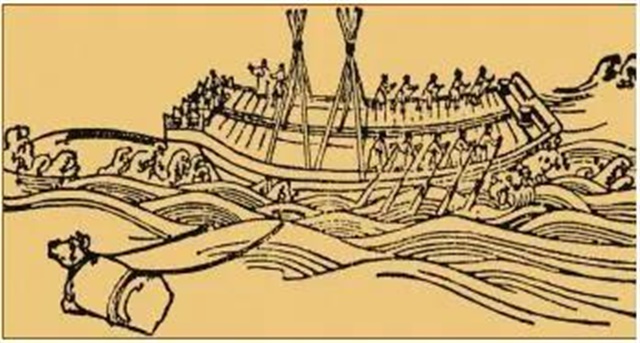
Picture of Huai Bing fishing out the iron bulls in the Song Dynasty
In the fifth stage, over about 542 years from the second year of the reign of Emperor Hongwu in the Ming Dynasty (1369) to the early year of the Republic of China (1911), Pujin Bridge was gradually destroyed due to the continuous collapse of the Yellow River and poor maintenance. In the second year of the reign of Emperor Hongwu, Xu Da, a famous general, led the army westward to conquer Shaanxi and ordered the last repair of Pujin Bridge. By 1886, the boat bridge was completely destroyed, with only the iron bull, iron man and mountain-shaped iron on the east bank left.
In the 1940s, the river flowed along the west wall of Puzhou City. As local old people recalled, horns of the iron bulls could be touched during the dry season, and the bottom of the boat was sometimes hit by the horns when the boat was driving. Due to the water storage in Sanmenxia Reservoir, deposition of river bed, and the westward river after the 1950s, the iron bulls had been buried 2m below the surface of the Yellow River by the 1960s and 1970s.
Excavation and Protection of Pujin Ferry Ruin
In the late 1980s, in order to extract materials for scientific research and develop tourist resources, Yongji County began to look for the iron bulls in the Yellow River and found them in August 1989.
From March to June 1991, led by the Shanxi Provincial Institute of Archaeology, a joint archaeological team with provincial, prefecture and county members was organized to first excavate the Pujin Ferry ruin. The excavation revealed the stratum and the distribution of the ruins from the Ming Dynasty to the Republic of China. Architectural remains dating back to the Jin and Yuan Dynasties were discovered, along with dykes and ferries from the Ming Dynasty, four iron bulls and four iron men, two mountain-shaped irons, three iron piers and seven-star columns from the Tang Dynasty. These findings completely revealed the look of the Pujin Ferry ruin.
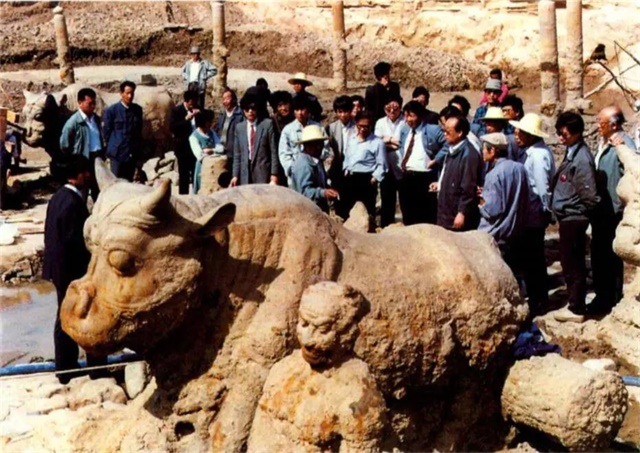
the site of the first archaeological excavation
How to protect the ruins was an issue widely concerned by all sectors of society. After the first excavation, the Natural Cultural Heritage Administration and Shanxi Provincial Government organized a number of meetings on demonstration of protection plan, and mainly three protection opinions were raised: The first proposal was on-site protection that maintained the original site, original position, and original appearance of the cultural relics; the second proposal was landfill protection until technical and capital conditions were improved; the third proposal was lifting protection with focus on protecting the most important iron cultural relics by lifting them in situ to keep away from the harmful moist environment.
After repeated demonstrations by experts organized by the Natural Cultural Heritage Administration, the protection principle was determined in March 1997 to lift the iron cultural relics by 12.2m and restore the ruins while getting prepared for the second excavation. The second excavation occurred from October 1999 to April of the following year. It clarified the stratigraphic relationship, the distribution of ruins, and the smelting, casting and burial of the ironware group from before the Ming Dynasty to the Tang Dynasty. These two excavations were extensive, covering 30m in the east-west direction, 50m in the north-south direction, and a depth of 12m.
The subsequent protection of the Pujin Ferry ruin was divided into three parts: civil construction, protection of iron cultural relics, and archaeological excavation and restoration of cultural ruins. During the process of project implementation, these parts of work intersected each other with the protection of cultural relics as the primary goal. Thus, the difficulty of the project was greatly increased, and the construction period was extended. Later, after many progressive adjustments in, for example, personnel, fund, and plan, "the Protection Project of Pujin Ferry Ruin" was finally completed upon acceptance and was delivered to the cultural relics management department concerned in early 2005. At this time, it had been 16 years since the iron bulls in the Yellow River were discovered.
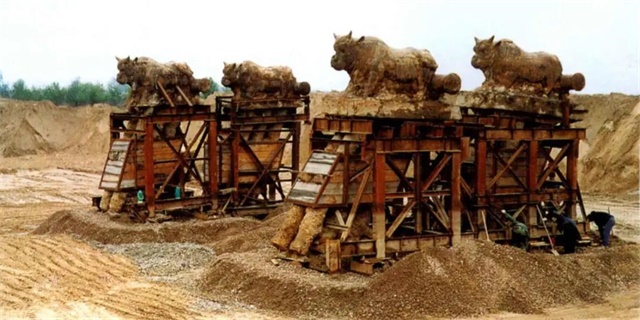
In-situ lifting of the ground anchors of the iron bulls
Iron Bull Relics Still New in the Floating Bridge Dating Back to the Tang Dynasty
Among the cultural relics excavated from the Pujin Ferry ruin, the most prominent ones were the iron bulls in the Yellow River. These iron bulls are the earliest, largest, heaviest, most and best ones ever found in a ferry. They reflect the superb smelting and bridge building technologies of the ancient Chinese people.
As cast sculptures, the iron bull group is lively and vivid, full of daring and lifelike dynamics. Textual research has confirmed that No. 1 is a bull, No. 2 a strong ox, No. 3 a castrated male ox, and No. 4 a three-year-old calf. Each statue is about 1.9m high, 3m long, and 1.3m wide, with a weight of about 30t. All of them have a horizontal shaft with a diameter of about 0.4m and a length of about 2.3m behind the tail to tie the iron chains. The head of the horizontal shaft is engraved with different patterns, including bead ornaments, diamond-shaped flowers, scroll grass, lotus flowers, etc.
These iron bulls are vivid in shape, with front legs in a stamping pose while hind legs in a squatting pose. They all have a robust and strong body, with the tail equipped with an iron shaft to tie the floating bridge. Zhou Jingzhu from the Qing Dynasty praised them for "having magnificent shapes, strong horns, heads raised, and a squatting posture strong enough to carry out heavy tasks and defend against hard attacks. Their legs are strong enough to resist and keep distance. Their eyes look ferocious and their eyes violent." There are mountain-shaped irons under their bellies. There are also six iron pillars with a diameter of 0.4m and a length of about 3.6m that are connected obliquely to the front. Each iron pillar has an outstretched iron foot functionally like a ground anchor. There are traces of casting seams and fits on the upper and lower parts of the iron bulls. Casting and fit traces can be observed and analyzed to reveal casting technology.
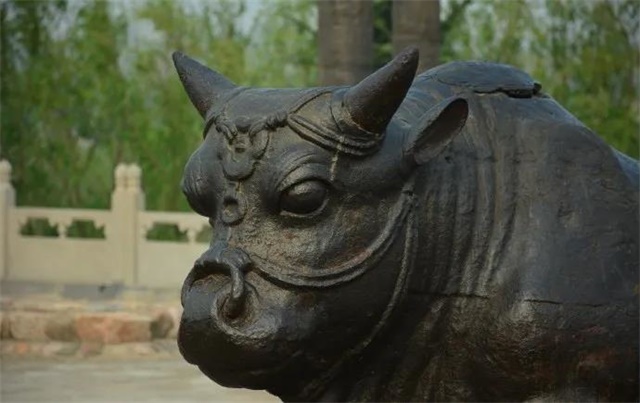
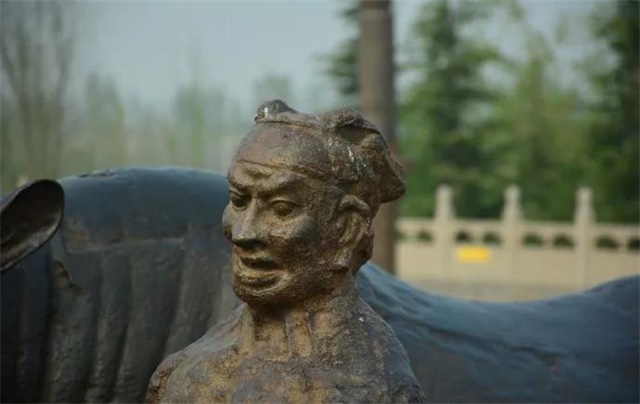
Parts of the iron bulls and iron men
Textural research on the excavated iron bulls reveals the specific casting process at that time. First, yellow wax was used as "wax molds" to shape the iron bull sculptures. The size of the wax molds was exactly the same as the actual finished products. Injection and discharge port were were reserved in the upper and lower parts. Second, the "wax molds" were evenly coated by specially made clean clay and baked in gentle heat after the shape was molded completely. During the drying process, wax solution would flow from the discharge port, turning the clay molds into hollow bull shapes. This casting process was called "clay molding". Third, the discharge port was blocked, the clay fit was reinforced, and molten iron was injected from the injection port. Fourth, step, after the molten iron solidified, the reinforcement facilities were removed and the clay fit was broken. The iron bulls were shaped.
In addition to the iron bulls, other excavated cultural relics include four iron men and two pieces of mountain-shaped irons. The iron men should be shepherds, varying in costume, facial expression, and movement. Based on these factors and their location and the friendly relationships between the Tang Dynasty and different ethnic groups at that time, the four iron men represent Uyghur, Mongolian, Tibetan, and Han nationalities. Behind the iron bulls and iron men is a line of seven-star iron pillars on the right. They form a unique rectangular matrix in a scientifically rigorous and meaningful manner. Zhou Jingzhu also described, “There are degrees everywhere, and they are firmly secured. There are pillars and mountain-shaped irons in addition to the bulls. The animals have their own shepherds who are either leading them or turning their head back to shout angrily at the animals."These excavated relics are found in clearly primary and secondary order and clear positions.
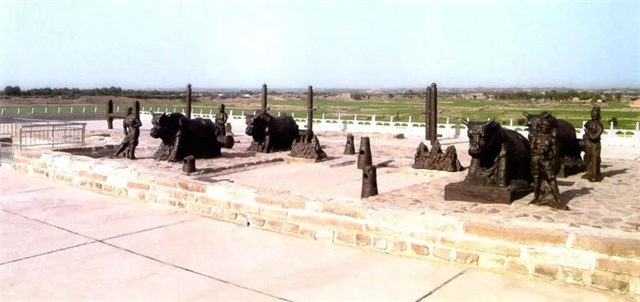
Ironware group in Pujin Ferry
Cultural Significance of the Iron Bulls in the Yellow River
Pujin Bridge has a magnificent shape and fully reflects the cultural and artistic styles of the Tang Dynasty. It was often praised by men of literature and writing over ages.
After the floating bridge was renovated, Zhang Yue, a duke of the Kingdom of Yan who was in charge of this major project, said in his Ode to Pujin Bridge, "So masters finished their job and different craftsmen contributed their techniques. In the Kingdom of Jin, iron was collected from people and six metals were smelted. Coal was burned violently as if done by mythical creatures, and furnace was tended in the spirit of the God of Fire. Smelting and cooking - the casting went on through trial and error. The iron became chains and melted to make bulls. The iron bulls stood on both banks, with their bosoms tied in the middle. Cables were used to maintain navigation, while the bulls were tied to the cables. The bulls could float water-repellent objects on beams between sparse boats. The heads of boats were carved with a water bird pattern to contain flooding and overflowing. When this new method has been established, it will become a permanent example for later generations." This record not only described the production method and usage of the iron bulls and iron chains, but also demonstrated the spirit and ethos of the Tang Dynasty.
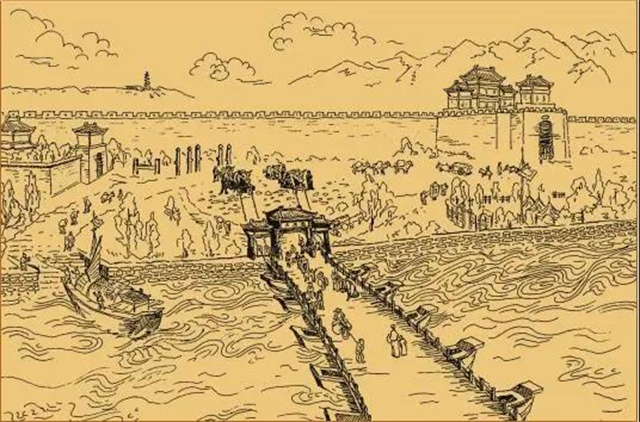
A map of the prosperous Pujindu Bridge
During the reign of Emperor Tianbao in the Tang Dynasty, Yan Boyu, who was an official in Huazhou, wrote in Ode to Pujin River Bridge, "It looks like a creature of god from a distance. It seems to be the rooftop of a waterfall and a sea island in Penglai...One could never know what will happen when boarding it, and ships travel dangerously. The bridge is like a dragon drinking river. The beams take on a gentle trend, doubtfully different from roc." In the Ode to the River Bridge, the writer Pi Rixiu praised Pujin Bridge for "looking like walking in air and venturing into danger. Its shape is like a sword outside the sky, or a dragon across the heart of river; it is as high as rainbow but still against wind; it also looks like a huge turtle in sea that won't sink in waves. When the light of early dawn shines, boats are lined and depart like roaring waters from river. When they come, the sound is like rain. When carriages come, the sound is like thunder." The poet Li Shangyin wrote in a poem, "The famous mountains on the left and right are invisible into distance, Boats are anchored in this big avenue in the east and west. Clever thoughts pass down for centuries, Making Pujin a wonderful destination." After visiting Pujin Ferry, Gu Yanwuin the Ming Dynasty also wrote a poem, "Iron bull relics still new in the floating bridge dating back to the Tang Dynasty, But they would be trapped in wind and dust for thousands of years when they are moved to a valley ashore. Without water even great turtles die, Without official duty, I live near the Stork Tower. I stay away from the court, But close to shepherd boys. The world is changing and I'm getting old, Wars are more frequent as time goes on. I'm so nostalgic about the ancient times, Western Qin would be a suitable place to adapt."
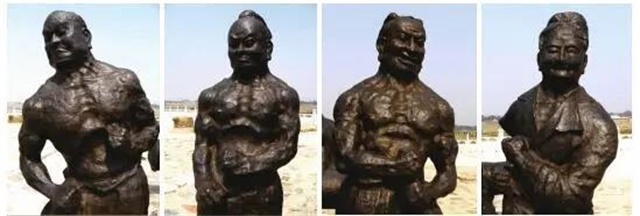
A half-length portrait of an iron man
According to the Chinese traditional cultural concepts, bulls have always been regarded as weapons to tame rivers. In The Book of Changes, "Bulls are like earth that could defeat water." The presence of a cast iron bull on a river bank symbolizes a deterrent to the flooding of the Yellow River and implies peaceful water that benefits the locality. At the same time, bulls have always been regarded as an incarnation of immense power, hard work, and willingness to give. They are regarded as a symbol that can bear burden and safeguard peace. As in the folk song that has been passed down for thousands of years in Shaanxi and Shanxi, "Seen from the tower, eight iron bulls stand to tame the river. The river gods are scared, and the people in Shaanxi and Shanxi are safe..."
The iron bulls in the Yellow River and other iron cultural relics in Pujin Ferry are of great significance for studying the metallurgical casting and bridge construction technologies, national costumes and living habits, and the policies towards different nationalities in the Tang Dynasty.